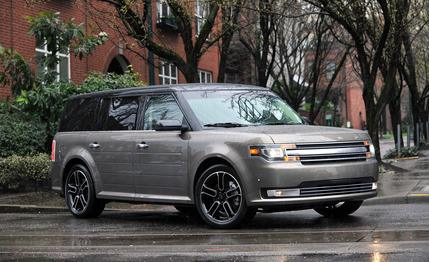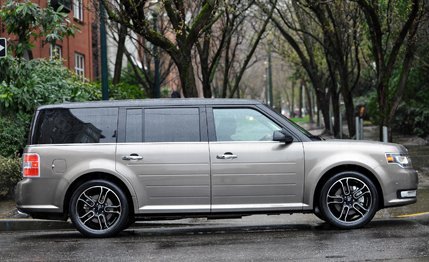 Instrumented Test
Instrumented Test

An entertaining subtext in the ongoing saga of the automobile is the phenomenon of a box with wheels that can dust at least two-thirds of the traffic mix at any given stoplight. In the case of the EcoBoost Ford Flex, two-thirds might be conservative. Make it 80 percent. Maybe even higher, given the ambush factor. With styling that seems to have been inspired by a refrigerator packing crate, the Flex is not a ride anyone would expect to be first across the intersection.
More Muscle
Yet Ford has mined more horsepower from both of the Flex’s 3.5-liter V-6 engines for 2013. With variable cam timing on both camshafts, the naturally aspirated version, which really needed some help, goes from 262 hp and 248 lb-ft of torque to 287 and 254, respectively. The optional turbocharged EcoBoost engine examined here, which was already pretty stout, received 10 more hp for a total of 365. Torque—350 lb-ft at 5500 rpm—from the turbo engine is unchanged.
With EcoBoost power, this giant breadbox is capable of hitting 60 mph in 5.7 seconds. Passing times are impressive, too: 30 to 50 mph in 2.8 seconds, 50 to 70 in 4.0. The twin-turbo V-6 generates these numbers despite downhill gearing and substantial mass: 4909 pounds in the case of our test vehicle, which included all-wheel drive as standard equipment. The last AWD Limited Flex we tested—with the old naturally aspirated V-6—weighed 4844 pounds and hit 60 in 8.4 seconds, and a pre-update, 4825-pound EcoBoost we clocked in 2009 did the deed in six seconds flat.

Both engines are allied with a very smooth six-speed automatic transmission, and the EcoBoost version includes paddle shifters affixed to the steering wheel. Here’s one place where Ford could have saved a few bucks. The shift response to paddle inputs is soft—in conventional drive mode, the transmission responds to right-foot demands just as quickly—and the idea that this feature makes the Flex any more appealing is wrong.
Rich power reserves come at a cost, of course. The turbo Flex is rated for 16 mpg city and 23 highway, and although the highway number is decent for something this shape, we logged a more realistic 17 mpg in mixed driving.
Less Rock ’n’ Roll
The turbo Flex’s alacrity out of the starting block has always been a pleasant surprise but a milder one this time around, since we’ve spent time with the previous edition. A bigger shock, based on the pre-2013 model, is what this latest version can do when confronted with a stretch of winding road.
The original was comfortable enough, but its transient responses were essentially elephantine—it had little interest in quick directional changes and even less ability to handle them. Subtle suspension adjustments make the updated Flex a much more willing companion for quick maneuvers, and they deliver reduced body motions, adequate grip, absolute predictability, and no sacrifice in ride quality.